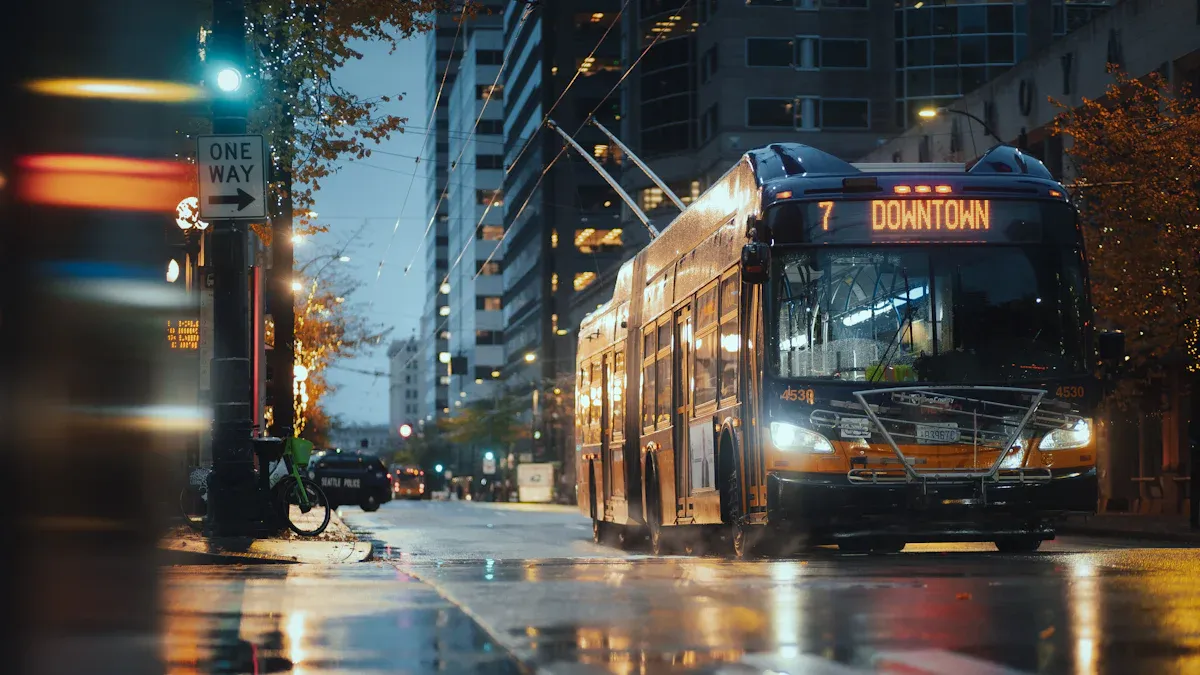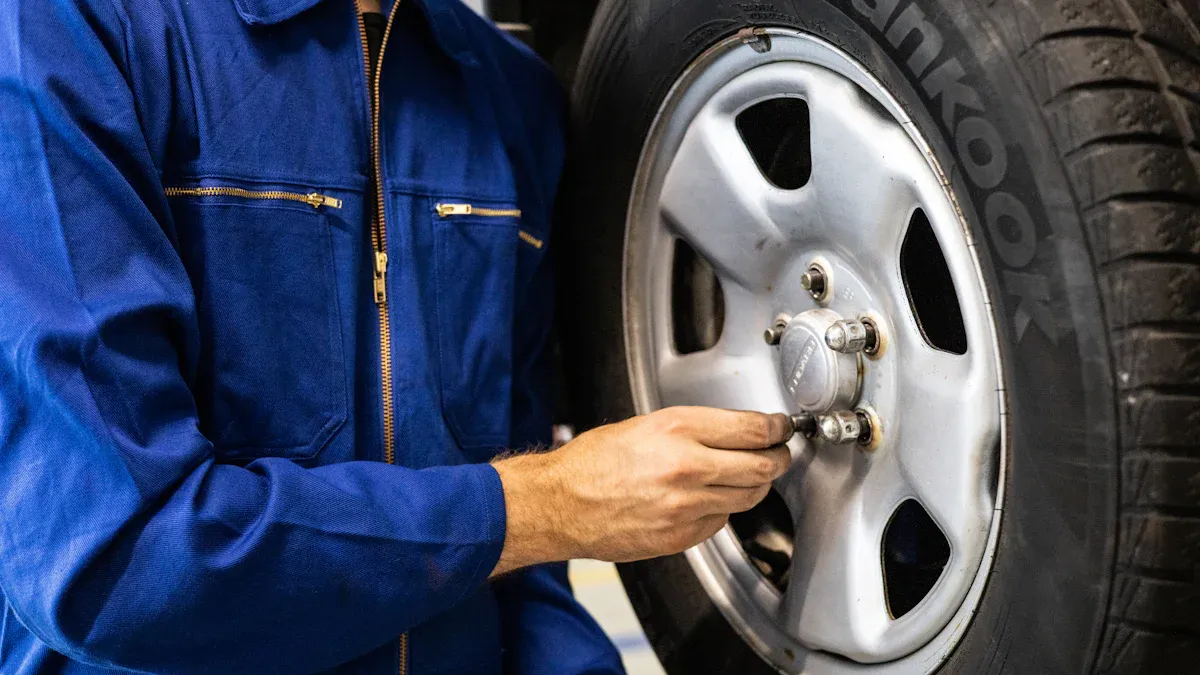
Tire tread checks are very important. They help keep you safe and working well in 24-Hour Delivery Fleets. This is especially true during late-night shifts. Bad tread can cause accidents or breakdowns. This puts deliveries and safety at risk. You must not ignore these checks. There are new solutions to help you check tires. These solutions let you inspect tires without stopping work. This way, your fleet stays on the road and ready to deliver.
Belangrijke punten
Checking tire tread regularly is very important for safety in 24-hour delivery fleets. Set up these checks to avoid accidents and breakdowns.
Automated inspection tools can save time and make checks more accurate. Use systems that watch tire conditions without stopping deliveries.
Plan tire maintenance during slow times to reduce downtime. Combine maintenance with delivery times for better efficiency.
Teach drivers how to inspect tires correctly. Give them tools like tire gauges to help with thorough checks.
Focus on tire maintenance to lower costs and improve fuel use. Good tires can save money and last longer.
Night-Shift Challenges

Running a 24-hour delivery fleet at night has its own problems. One big issue is low visibility. When you drive after dark, accidents are more likely. A survey found that 86% of truck drivers think driving accidents have increased in the last five years. Here are some common visibility problems you might face:
Low light makes it hard to see signs and obstacles.
Bright headlights from other cars can blind you for a moment.
Dark delivery areas can be dangerous when parking or unloading.
To deal with these problems, you can do a few simple things. Parking in bright areas helps you see better. Keeping your headlights on while driving and walking to deliver makes it safer. Also, using a good flashlight instead of your phone’s flashlight gives you better light without using up your battery.
Another problem is scheduling tire maintenance with delivery times. You want to keep your trucks moving, but checking tires is important for safety. Here are some tips to help you manage this:
Combine maintenance schedules with delivery times to avoid issues.
Plan maintenance during slow hours to reduce interruptions.
Remember that unexpected maintenance can cause vehicle downtime, which affects deliveries.
By planning your tire checks with your delivery routes, you can keep your fleet safe and running well, even at night.
Automated Inspection Technologies
In our fast-moving world, technology is very important. It helps keep your fleet safe and running well. Automated inspection technologies help you find tire problems quickly. This is very important for 24-hour delivery fleets. These systems use special tools to check tire conditions. They do this without stopping your work. Here are some key technologies that make a difference:
AI-Powered Inspection: Amazon’s Automated Vehicle Inspection (AVI) technology finds problems in delivery vans. It does this before they cause breakdowns. This makes your fleet safer and more reliable.
UVeye’s Technology: This system checks the undercarriage, outside, and tires of vehicles. It allows for easy remote monitoring. This helps you find flat tires, tread problems, and oil leaks without needing to inspect them in person.
Automated inspection systems have many benefits over manual checks. Let’s see how they compare:
Kenmerk/Voordeel | Automated Inspection Systems | Manual Inspection Methods |
|---|---|---|
Snelheid | Work all the time without breaks or tiredness | Limited by how much a person can do |
Volume of Inspection | Check thousands of tires each shift | Slower, can only check a few |
Nauwkeurigheid | More accurate, fewer mistakes | Can have human errors |
Real-time Analysis | Finds problems right away | Takes time to get feedback |
Adaptability | Learns to adjust to different tire types | Not flexible, stays the same |
With these technologies, you can save time and make things safer. For example, automated inspections take about 5 minutes per vehicle. Manual checks can take over 30 minutes. That saves you 25 minutes! This lets your team focus on deliveries instead of spending hours checking tires.
Realtime bewaking systems also give you constant data on tire pressure and temperature. This means you get alerts right away if something is wrong. Here are some key features of these systems:
Key Feature | Omschrijving |
|---|---|
Realtime monitoring | Gives constant data on tire pressure and temperature, so you get alerts quickly. |
GPS Tracking | Helps track fleet locations, making it easier to manage trailers and fix problems. |
Mobile Compatibility | Has a user-friendly app for alerts and tire data on smartphones. |
Durability | Made to last in tough conditions, like extreme heat and moisture. |
Battery Life | Long-lasting batteries mean less maintenance and better efficiency. |
Data Analytics | Gives insights into tire performance, helping with maintenance and planning. |
Integration Capabilities | Connects easily with current fleet management systems for better workflows. |
By using these technologies, you can lower tire-related breakdowns during night shifts. Continuous monitoring helps you fix problems before they become big issues. With 24/7 alerts, you can act fast on tire problems, keeping your fleet safe and working well.
Best Practices for 24-Hour Delivery Fleets
Adding tire checks to your night-shift routine is very important. It helps keep your fleet safe and running well. Here are some good strategies to help you:
Check tire pressure and tread depth every month. This helps you find problems early and fix them quickly.
Teach your drivers how to inspect tires properly. This makes sure they know what to look for and can do thorough checks.
Give each vehicle the right tools, like tire gauges. This helps drivers check tires easily and often.
Planning tire inspections can be hard, especially during busy night shifts. One smart way is to use mobile preventive maintenance. This lets you schedule checks during slow times, like when trucks are parked or during driver breaks. This way, you reduce downtime and keep your vehicles ready for deliveries.
Training your team is just as important as having the right tools. When your staff knows how to check tires well, they can find problems before they get worse. Regular training sessions can help keep these skills sharp and focus on safety.
Remember, a well-trained team and a good inspection routine can lower the chances of tire problems. This smart approach not only improves safety but also makes your 24-hour delivery fleets work better.
Benefits of Tire Maintenance

Taking care of your tires is very important for your fleet’s safety and efficiency. Regular tire maintenance can greatly improve safety and lower accident rates. In fact, about one in three accidents on the road happen because of tire problems. By keeping your tires in good shape, you reduce the chances of accidents and make deliveries safer.
Here are some main benefits of taking care of your tires:
Kostenbesparing: Preventative maintenance programs can help fleets save 30% on maintenance costs over the vehicle’s life. This means you can use those savings for other important parts of your business.
Improved Uptime: Taking proactive steps like checking tires often can cut down on unexpected breakdowns. Predictive maintenance can increase vehicle uptime by 25% and save about $2,000 per truck each year. This keeps your fleet on the road longer and helps with delivery efficiency.
Better Fuel Efficiency: Well-kept tires help save fuel by reducing rolling resistance. This not only saves you money at the gas station but also helps the environment.
Verlengde Bandlevensduur: Regular tire care lowers overall costs by making tires last longer and needing fewer replacements. Using tire pressure monitoring systems can save around $1,493 per vehicle.
By adding these practices to your routine, you can make sure your 24-Hour Delivery Fleets run smoothly and efficiently. Remember, paying attention to your tires can greatly improve safety and save money.
In conclusion, taking care of your tires is very important for the safety and efficiency of your 24-hour delivery fleet. By using new ideas and good practices, you can lower the chances of tire-related accidents.
Think about these important points:
Key Point | Evidence |
|---|---|
Tire-related accidents | 11,000 crashes each year could be stopped with good tire care (NHTSA) |
Recommended tread depth for replacement | Change tires at 4/32 in. to lower accidents and repair needs |
Use technology like TPMS and automated checks to keep your fleet running well. Remember, a fleet that is well taken care of not only improves safety but also helps your profits. So, act now and make sure your tires are always in great condition! 🚚✨
Veelgestelde vragen
When is the best time to check tire tread during night shifts?
Check tire tread during breaks or when vehicles are parked. This helps you avoid downtime and keeps safety without messing up delivery times.
How often should I inspect tires?
Try to inspect tire pressure and tread depth every month. Regular checks help you find problems early and keep everything working well.
Can automated inspection technologies take the place of manual checks?
Automated technologies improve tire inspections but should not fully replace manual checks. Using both methods makes sure you monitor thoroughly and find problems quickly.
What are the signs that tires are worn out?
Watch for uneven tread wear, cracks, or bulges. If the tread depth is less than 4/32 inches, it’s time to get new tires for safety.
How can I train my drivers to inspect tires well?
Give hands-on training sessions that teach proper inspection methods. Use visual aids and checklists to help drivers remember what to look for during their checks.
Zie ook
The Importance of Monitoring Your Tire Tread Depth
Inzicht in slimme profiel diepte detectors en hun werking
Gebruik een bandenslijtdrekdieptemeter voor nauwkeurige metingen






